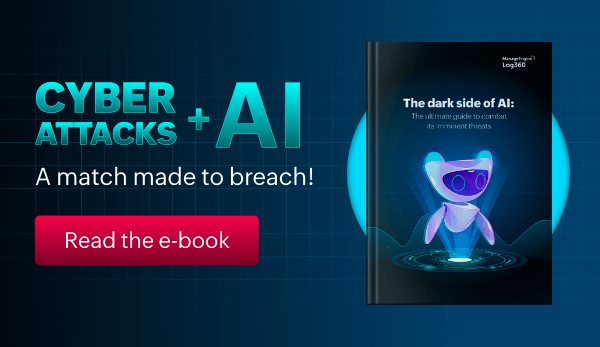SIEM library
Enhance your security posture with the power of cyberthreat intelligence
In this page
- What is cyberthreat intelligence?
- Implementing cyberthreat intelligence
- Best practices for maximizing cyberthreat intelligence
An informed and proactive defense strategy is essential in today's cyberthreat landscape. Cyberthreat intelligence stands as a crucial tool for organizations, helping them anticipate and combat cyber risks. Rather than just presenting raw data, cyberthreat intelligence provides:
- Insights into the motives of cyberattackers.
- Knowledge of their potential targets.
- An understanding of their tactics.
By offering this depth of information, cyberthreat intelligence transforms old, reactive security methods into a proactive strategy to ultimately improve an organization's security posture. A harmonious relationship exists between threat intelligence and cybersecurity, and combining them results in a strong threat intelligence platform, acting as an organization's security backbone. This platform can:
- Identify threats meticulously.
- Analyze the risks and vulnerabilities in depth.
- Mitigate potential threats effectively.
Understanding the core concepts
1. What is cyberthreat intelligence?
Threat intelligence is a well-structured repository of evidence-based knowledge. This refers to the context, mechanisms, indicators, and actionable insights regarding existing or emerging threats targeting digital assets.
At its core, cyberthreat intelligence is about understanding and anticipating cyber adversaries through:
- Reliable data sources:These provide a real-time stream of information about ongoing security events, which can help predict potential outcomes. Industry-specific data, such as trends in e-commerce cyberattacks, offer tailored insights, enhancing the specificity and relevance of threat intelligence.
- Qualified analysts:Analysts play a crucial role by interpreting the data, identifying the threat actors and their potential targets, and strategizing countermeasures. Their analytical prowess ensures that the data is not just consumed but is transformed into actionable intelligence.
- Robust processes:Ensuring that insights from threat intelligence are acted upon requires streamlined processes. This involves empowering the IT department to act swiftly, ensuring that policies are continuously evaluated and updated based on the evolving threat landscape.
2. What is threat detection?
At the heart of cyberthreat intelligence is threat detection. Serving as the frontline defense against cyber adversaries, threat detection tools employ advanced analytics, ML, and real-time analysis to identify potential threats preemptively. Threat detection is not merely about installing monitoring software; it is about classifying data, assigning apt security permissions, and ensuring a real-time, proactive response to any detected anomalies. By correlating threat indicators and analyzing user behaviors, threat detection and response tools offer a robust shield against known threats and novel, emerging cyber challenges.
As cyber adversaries evolve their tactics, techniques, and procedures, enterprises must counteract them with enhanced insight and foresight. This is where the intersection of threat intelligence and cybersecurity becomes pivotal. By seamlessly integrating with existing cybersecurity mechanisms, threat intelligence platforms facilitate a comprehensive approach to fortifying digital assets.
3. Implementing cyberthreat intelligence
The sources of threat intelligence are categorized into two broad types: internal and external.
- Internal sources:These are drawn from an organization's own infrastructure. Key components include security information and event management (SIEM) systems, application logs, firewall and DNS logs, and historical data on past security incidents. This data aids in the understanding of system vulnerabilities, exploited weak points, and indicators of compromise (IoC).
- External sources:This intelligence is derived from outside the organization. Examples include open-source intelligence such as blogs, news reports, and public block lists; commercial threat intelligence software vendors; and corporate and open source sharing groups that collaboratively discuss potential cybersecurity threats.
These sources, when properly harnessed, provide a comprehensive view of the threat landscape, allowing for proactive security planning, efficient incident response, and strategic alert and blocking mechanisms.
4. Integrations
SIEM solutions aggregate log data from multiple applications, systems, and networks, providing visibility across diverse sources and aiding in real-time identification of potential attacks.
Combining SIEM with diverse threat sources elevates its capabilities, bringing the combination of the latest threat data sources into the fold for faster identification and mitigation. The synergy between SIEM and cyberthreat intelligence is essential in ensuring organizations remain a step ahead, even in a rapidly evolving cyber landscape. Incorporating threat intelligence platforms with SIEM and endpoint detection and response (EDR) solutions makes it a formidable triad, with the threat intelligence platform acting as the centralized hub for all cyberthreat intelligence data. As Anton Chuvakin, a former research vice president at Gartner and a recognized expert in the cybersecurity field, aptly noted, “SIEM and threat intelligence feeds are a marriage made in heaven.” And when integrated with SIEM alerts, detection and response capabilities of threat intelligence are enhanced and streamlined.
5. Threat hunting
Threat hunting has emerged as a proactive approach to preventing cyber incidents, with security teams actively scouring systems guided by the invaluable insights provided by cyberthreat intelligence. Knowledge about potential or actual cybersecurity threats empowers these teams to make informed decisions.
Accentuating this process is the concept of intelligence fusion, which involves compiling, analyzing, and sharing diverse data to anticipate and counter threats, enhancing security by connecting the dots between criminal activities and potential risks. By correlating data from various sources, SIEMs can efficiently identify signs of threats, often recognized by indicators of compromise (IoCs). These signs, when combined with information from threat feeds, automate the threat hunting process. With the backing of threat intelligence, teams can tactically navigate the security landscape, outsmarting potential attackers at every corner.
6. Enhancing threat detection and mitigation within the organization
Recognizing vulnerabilities within the infrastructure and addressing them is paramount. Cyberthreat intelligence plays a pivotal role in this endeavor. By weaving together external intelligence with internal data, organizations can sharpen their detection mechanisms and improve their mitigation strategies.
Integrating tactical threat intelligence into existing security tools, like intrusion detection systems, SIEMs, and firewalls, ensures automatic protection against recognized threats. For instance, when an attack is underway, cyberthreat intelligence can be leveraged for threat hunting, allowing security teams to actively look for signs of an assault rather than passively waiting for alerts. Operational intelligence equips security professionals to sift through subtle cues, such as registry adjustments or running process changes, narrowing their search based on the attacker’s motivations. These are some of the many ways cyberthreat intelligence can enhance an organization's ability to detect both internal and external threats quickly, prioritize them, and swiftly respond.
Best practices for maximizing cyberthreat intelligence
Prioritize continuous learning and adaptation
To maintain a robust defense against advanced persistent threats, organizations must evolve their threat intelligence strategies and commit to continual learning and adaptation. Essential practices should include:
- Investing in lifelong education for personnel:Prioritizing cybersecurity education with comprehensive, regular training initiatives ensures teams are vigilant and ready to act, reinforcing the organization's defensive posture.
- Fostering a proactive learning culture:Encourage a workplace environment where staying informed about the latest in cybersecurity is part of the ethos. This proactive stance significantly strengthens an organization's resilience against cyber adversaries.
Enhance collaboration and information sharing
Fully unlocking the potential of cyberthreat intelligence takes a collaborative effort. Strategic sharing of information among organizations improves the effectiveness of threat intelligence:
- Expanding threat intelligence sharing:Organizations should participate in the proactive sharing of insights regarding malevolent activities and threat actors. This collaborative approach, often facilitated through standardized intelligence feeds and platforms, renders a panoramic view of the threat environment and enhances the collective security posture. Effective information sharing extends beyond improving individual defenses and fosters a sense of community and trust among stakeholders.
- Encouraging public-private sector synergy:Initiatives like the Cybersecurity Information Sharing Act (CISA) of 2015 are instrumental in diminishing the intelligence gap between public and private sectors. This solidarity is crucial for presenting a unified defense front against cyberthreats.
Adopt advanced technologies
Leveraging innovative technologies is pivotal in revolutionizing approaches to cyberthreat intelligence:
- Integrating AI and ML in cybersecurity:These technologies are invaluable for scrutinizing massive datasets in real-time and identifying irregularities, trends, and potential threats. Particularly, AI-driven threat intelligence is game changing in its enhancement of threat identification and remediation processes.
- Employing natural language processing (NLP):Utilization of NLP allows organizations to delve into unstructured data, offering a broader understanding of looming threats, thus fortifying security measures.
- Enabling automated response and mitigation:The use of AI-facilitated procedures ensures prompt, efficient responses to threats, significantly narrowing the window of opportunity for cyberattacks, and thereby safeguarding organizational integrity.
The trajectory of cybersecurity is clear: a future empowered by threat intelligence, proactive measures, and a keen emphasis on adapting to new technologies and methodologies. As your organization charts this path, the integration of cyberthreat intelligence will be instrumental in shaping a robust and resilient security posture.




